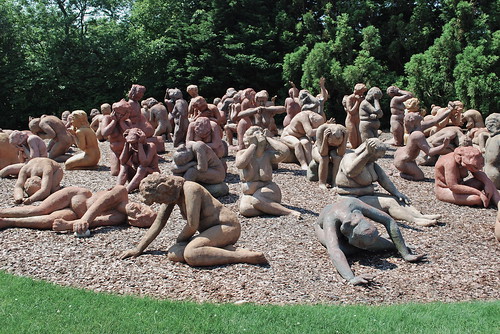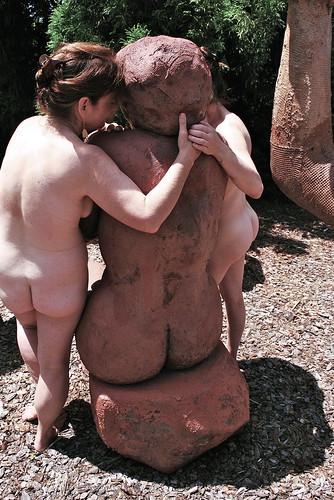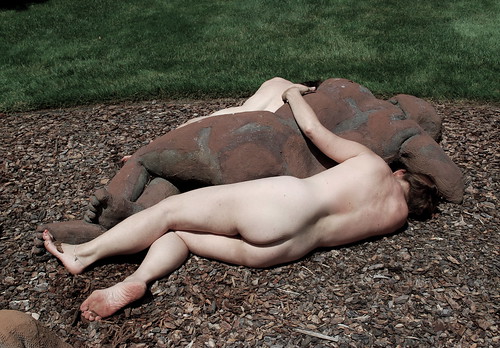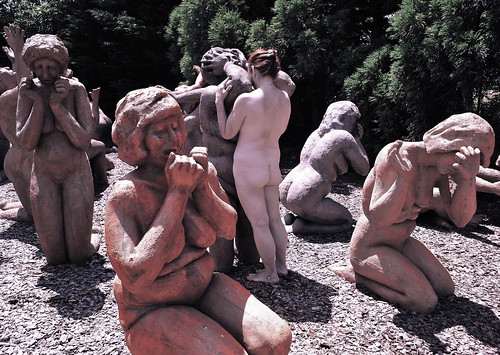
“We’ve got some extra time,” my friend Ocean Breeze said the day I arrived at her beach house. “I want to show you a sculpture. It’s currently set up in the artist’s backyard, but she allows people to visit.”
As we drove, she began telling me about the art installation. “The artist lost her son in a terrorist attack — when an airplane exploded over Lockerbie, Scotland in 1988.”
“Dark Elegy? That’s here?” I asked.
She looked surprised. “You know it?”
“I’ve seen it before,” I said. “I taught at Syracuse University in the 1980s. We lost 35 students on the flight. Including her son. I had a student on that flight.”
The work of art is unforgettable. After the 1988 terrorist attack, artist Suse Lowenstein did a sculpture of herself, posed in that first moment of grief. Then other mothers and widows came to her studio. She talked to each, then asked them to remember with their bodies the way they felt when they first heard the news the plane had crashed.
She made 75 figures altogether, all just a little bit bigger than life. Some are screaming, some are pleading, some are begging or praying or falling. Some are reaching out, some are pulling inward, one is curled up like a baby. The figures are real women, with real bodies – breasts and hips and tucks of belly fat – and stripped of their clothing, they could be from any background.
When Dark Elegy traveled to the Syracuse University campus in 1995, I spent an afternoon looking at the grieving figures, and I’d never forgotten them. The art seemed even more powerful now, perhaps because I brought with me more experiences with life and with death. I walked amongst the statues, looking at each woman, feeling overcome with the many shapes grief can take. I thought about the student I’d taught many years ago, only 21 years old when he was killed, and wondered if his mother had posed.
A few days later, we returned with our friends. Ocean Breeze sat quietly at the edge of the circle with her journal. Jaybird wiped tears away as she walked amongst the figures. Ecowoman kept touching the statues, putting her arms around first this one, then that, as if to comfort them. Yoga Woman stood perfectly still, holding her body carefully upright, as she gazed intently at each grieving woman.
Ecowoman spoke to me in an undertone, the way you would whisper in any sacred place.“I want to hug them,” she said. “They’re statues, but they’re real women too. I can’t help wanting to touch them.” I knew what she meant. By the time you are my age, you recognize the gestures of grief; they resonate. Ecowoman had arrived late at our gathering because she’d been sitting shiva for a beloved cousin.
When the artist came out to her back patio, we walked over to talk to her. When I said the first name of my student, she gave me back his full name, immediately. “Yes,” she said, before I even asked. “His Mom is in there.”
Dark Elegy was supposed to be installed in Washington DC as a monument to all victims of terrorism, an invitation to remember history and work for a peaceful future. The artist herself agreed to fund the project. But then the National Capital Memorials Advisory Commission turned the project down because they were afraid that statues of naked women might be “offensive.” That’s why this amazing piece of art is still in the artist’s backyard.
Ecowoman wanted to take her clothes off and walk naked among the grieving women, in solidarity. “That’s where my naked photo will be,” she said to me. She asked permission from the artist, who said, “Sure, go ahead.”

“This bright sunlight will be harsh,” I warned Ecowoman. She shrugged and stripped off her clothes. I think she forgot about my camera as she stepped up to first one statue, then the next. She touched them, comforted them, even lay down on the mulch to grieve with them. Free Woman, when she saw what we were doing, joined in.

We didn’t talk much. In the presence of such grief, there wasn’t much to say. The women’s bodies said it for us. When finally, it was time to gather our journals and leave, Yoga Woman turned to the sculpture and did some kind of yoga move that paid tribute to the artwork with her body. Then we drove back to the beach house in silence.


33 comments:
Having the living bodies amidst the clay bodies is somehow haunting. Beautiful post.
Your pictures and post are especially moving. I've never heard of this, but it's beautiful.
I cried and cried and cried (and am still crying) when I read this. I so remember this.
I remember reading about this piece and seeing images from it at a local gallery years ago. Seeing it all together really hits home.
Wow. So powerful, and so timeless. This could be a monument to ANY tragic loss.
Grieve not for the dead, but those left to survive.
This had me sobbing. How could anyone be "offended" the morons.
Jo(e), I've loved all of your naked photos, but these are the most powerful.
I have never heard of this work before. It is so moving, so compassionate, so raw. It knocks me out. These naked photos are spectacular. They touch something so deeply that it reminds me of what it must have felt like once, a long time ago, to live in community. Stunning.
A powerful response to what happened in Colorado. So far yours is the only commentary that's made sense to me.
So naked women are ok in paintings in the National Gallery but not in a monument to grief? Does that even make sense? Or is it naked grieving mothers that is so offensive?
Beautiful art, beautiful photos, and beautiful post. You've outdone yourself (and that is not an easy thing).
weeping.
wow, jo(e), just wow.
Thank you.
what tracynicholrose said. This is amazing...the work, how you and your friends participated in it, and it's horrifying it's not publicly displayed.
I was working in study abroad when that plane crash happened and it hit hard, all those kids on their way home from their experience of a lifetime. It still breaks me up. And now, more so.
I had a profoundly haunting experience the day that plane was exploded. It has been years since I sat with that memory in silence, but I did so after reading this today.
Thank you for this post.
it seems as if the project you are doing of the naked photos somehow brought you here--the combination of the living and the sculpted women is so powerful and, just, right.
I remember this tragedy but wasn't aware of the memorial, let alone the decision to move this away due to some being afraid of the stripped away grief.
Others used "powerful" in their descriptions...and that was the first word which entered my head when viewing this.
I'm wondering if the United States Institute of Peace has considered housing this powerful and beautiful artwork...such an honest 'capture' of the 'to the core grief' that remains following acts completely devoid of love and peace...such a resounding call to create a kinder, gentler world.
Beautiful post and photos, Jo(e).
thank you.
Very moving post; thank you for sharing.
What a powerful work- and a diversity of moving responses from your community.
It's a real shame that this work isn't a public one. Remember the women of Liberia, who worked hard to stop the violence, sometimes by taking off their shirts to shame the men? That's what this naked grief begins to do- and why this piece is so threatening to those who wage violence.
That is so powerful, and moving.
This moves me beyond where it reasonably should. I have never lost anyone to such a horrible event, but I felt a kinship with these women as I read your post. Oh, where is the comfort in this world? This sculpture deserves a highly visible place in our culture. At the very least, I selfishly want to see it.
Sigh, powerful words, and pictures.
I was just starting high school when it happened, and attending Little Green School next to SU when the statues came to campus. I didn't dare touch them tho, seemed, wrong somehow...
I have walked through this sculpture countless times, yet your essay about our experience there on this particular day opened another way of seeing the grieving women as not just caught in the moment of loss but also as “real women, with real bodies.” Beautiful post. Thank you.
Jo(e), I remember when the sculptures were still on campus, and the effect of snow on them. Unforgettable.
T.
This is what we women do--Pick up each others' grief and wrap ourselves around one another when we see one of our own exposed and suffering. How beautiful and aching this is about our sex. You and the artist have captured it perfectly. No words needed to know what is happening. Your friends are the kind of women I treasure the most in life.
Please sign and share the following petition to make Dark Elegy a national monument: http://www.change.org/petitions/national-capital-memorials-advisory-commission-make-dark-elegy-a-national-memorial-to-victims-of-terrorism-in-washington
We need more posts like this, more photos, more places that so succinctly highlight our common ties.
Beautiful.
"The gestures of grief" - so hauntingly universal. I can't imagine anyone being offended once they saw a single face.
This made me lose my breath.
This is so beautiful. Thank you for writing and posting it; thank you to your friends for their love and for posing. And thank you to the sculptor. I'm completely moved.
I did not know this amazing work existed. I worked in the Lockerbie mortuary from day 1 after the disaster as a forensic odontologist identification expert. I remember with great sadness the many scenes in Lockerbie and always take time to stand in silence at the Lockerbie memorial when driving to Scotland.
A very moving piece of work which I wish it had come to Lockerbie for the public to view. How short sighted of officialdom in the US preventing public viewing. I have dealt with relatives and this is so realistic
Post a Comment